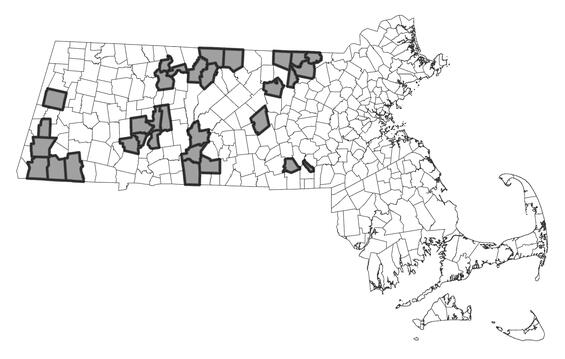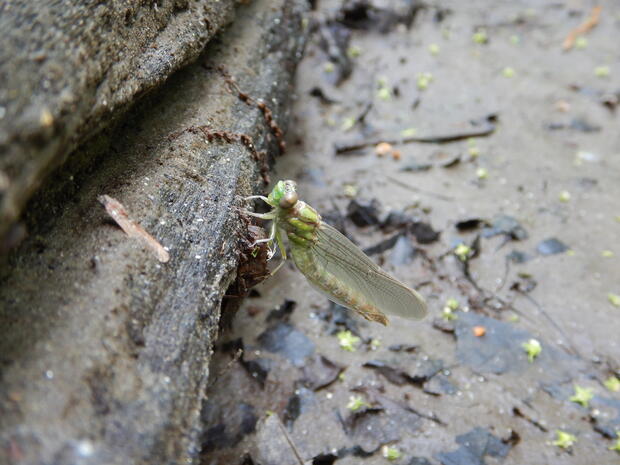- Scientific name: Ophiogomphus aspersus
- Species of Greatest Conservation Need (MA State Wildlife Action Plan)
- Special Concern (MA Endangered Species Act)
Description
Male brook snaketail
The brook snaketail (Ophiogomphus aspersus) is a large, slender insect belonging to the order Odonata, suborder Anisoptera (the dragonflies), and family Gomphidae (the clubtails). The clubtails are a large, diverse group of dragonflies named for the lateral swelling at the tip of the abdomen that produces a club-like appearance which varies greatly among species. Clubtails are further distinguished from other dragonflies by their widely separated eyes, wing venation characteristics, and behavior. The brook snaketail is a member of the genus Ophiogomphus (the snaketails) that are characterized by their brilliant green thorax, eyes and face. The thorax is mostly green with narrow, dark lateral and shoulder stripes. Abdominal segments possess pale-yellow dorsal markings on all segments. Markings on segments one through eight possess rearward-pointing daggers and variably shaped mark on segment nine. The swelling in the abdomen forms a club that is over half the width of the thorax. Legs are black with pale femurs. Females are similar to males but stockier overall except for the club.
Adult brook snaketails range from about 44 -49 mm (1.7-1.9 inches) in length. Fully developed nymphs range from 25-27mm (~ 1 in).
Although snaketails may be easily recognized to genus by their brilliant green thorax and face, it can be difficult to identify them to species. Five species of Ophiogomphus have been recorded in Massachusetts. All of these are similar in coloration, size and shape. The shape and size of the dorsal abdominal markings differ between species and may help to identify the various species of Ophiogomphus. However, these markings can be variable and should be used in combination with other factors to make definitive identifications. The most reliable way to distinguish males of the genus Ophiogomphus from each other is by examination of the terminal abdominal appendages and hamules (organs located on the underside of segment 2). Females may be identified to species by the shape of their vulvar lamina (located underneath segments eight and nine) and by the shape of small spines and bumps located on top of the head. The nymphs and exuviae can be distinguished by characteristics of the dorsal spines on the abdomen and characteristics of the antennae, as reported in keys by Walker (1958) and Soltesz (1996), and Tennessen (2019).
Life cycle and behavior

Note, nymphs are present year-round.
Brook snaketails are elusive and little is known about their life history. The egg and nymph life stages are fully aquatic. The nymphs are predators, feeding on a wide variety of aquatic insects, small fish, and tadpoles. Nymphs spend much of their time burrowing in the bottom sediment in depositional habitats that provide them protection from predators and camouflage to catch prey. Nymphs undergo several molts (instars) for at least 2 years until they are ready to emerge as winged adults. When ready to emerge, typically in late May, the nymphs crawl out onto exposed rocks, emergent vegetation, partially submerged logs, or the steeper sections of riverbanks, where they undergo transformation to adults (a process known as eclosion). Emergence generally takes in the morning, presumably to reduce exposure to predation. This species and other Ophiogomphus emerge in synchrony whereby many individuals emerge over a short time. The cast nymphal exoskeletons, known as exuviae, are identifiable to species and can be a reliable, useful means to determine the presence of a species.
As soon as the freshly emerged adults are dry and the wings have hardened sufficiently, they fly off to seek refuge in the vegetation of adjacent uplands. Here, they spend several days or more feeding and maturing, before returning to their breeding habitats. During this time of wandering and maturation, brook snaketails can be found in fields and forest clearings, sometimes far away from the breeding site, perched horizontally on sunlit vegetation or the ground. When the maturation process is complete, the adults return to the stream to breed. In Massachusetts, the brook snaketail probably breeds from early June through August. Upon returning to the stream, males can be found perching on rocks in the middle of the streams. From these exposed perches they make swift patrols out over the water, often returning to the same or a nearby rock. During these patrols, the males are primarily searching for mates and driving off any potential competitors. Females spend little time around the breeding habitat, except during the brief time when they are ready to mate and lay eggs. Mating may take from less than one minute to over an hour depending on the species. It is not known how long it takes in the brook snaketail. When mating is completed, the female returns to the water to deposit her eggs. Females oviposit alone by tapping the tip of their abdomen to the surface of the water. This is usually done around a riffle in the stream as she flies rapidly back and forth over the water.
Brook snaketails have long flight seasons with emergence beginning in late May and early June and adults on the wing into August.
Distribution and abundance
The brook snaketail occurs from Nova Scotia west to Quebec, south to North Carolina and Kentucky. It has been found in all New England states. In Massachusetts, the species occurs in the Housatonic, Middle Connecticut, Millers, Chicopee, Nashua, and Blackstone watersheds. Exuviae and adults are typically observed in low abundances, especially compared to co-occurring Ophiogomphus species (O. rupinsulensis, O. mainensis), but have been found in higher abundances at a few sites.
The brook snaketail is listed as a species of Special Concern in Massachusetts. As with all species listed in Massachusetts, individuals of the species are protected from take (picking, collecting, killing, etc.) and sale under the Massachusetts Endangered Species Act.

Distribution in Massachusetts.
1999-2024
Based on records in the Natural Heritage Database.
Habitat
Brook snaketail inhabit small to medium-sized streams that are usually clear and cooler. Substrates are typically sand with intermittent riffles of gravel and cobble. Clean sand deposits may correlate with species nymph and exuviae occurrence (Gibbs et al. 2004). The adults inhabit riparian areas, forested uplands, fields, and when mature are often flying over swifter currents around riffles.
Healthy habitats are vital for supporting native wildlife and plants. Explore habitats and learn about conservation and restoration in Massachusetts.
Small, cool-water stream with sandy substrate suitable for brook snaketail.
Threats
Degradation of water quality, alteration of streamflows, and upland habitat loss are primary threats to brook snaketail. Potential threats to water quality include pollution and sewage overflow, salt and other road contaminant run-off, and siltation from construction or erosion. The disruption of natural flow regimes by flow regulation projects, damming, and stream channelization may have a negative impact on populations. Warming stream temperatures from climate change is projected to reduce brook snaketail habitat in Massachusetts (Collins and McIntyre 2017). Additional threats include illegal or accidental industrial discharge and hardening of channel banks and siltation that creates unstable stream habitat.
Conservation
Survey and monitoring
Since adults can be difficult to detect because of their elusive behavior, exuvia not only provides increased detection but also site-specific locations of aquatic nymph and breeding habitat.Surveys may target adults in combination with exuviae but never alone. Robust stream populations should be routinely monitored every five years or to the extent practical to document changes in occupancy and habitat conditions. Effort should also target new streams and stream segments identified as potentially suitable habitat. It’s possible the species occurs in more streams than currently known.
Management
Upland and stream habitat protection is critical for the conservation of brook snaketail. Protection of forested upland borders of these river systems are critical in maintaining suitable water quality and are critical for feeding, resting, and maturation. Development of these areas should be discouraged, and the preservation of remaining undeveloped uplands should be a priority. Alternatives to commonly applied road salts should tested to minimize freshwater salinization. Hardened and channelized stream segments should be restored to promote natural sediment dynamics.
Research needs
Continued effort is needed to define habitat requirements, distribution, relative abundance, and potential breeding sites to update the species status in Massachusetts. Estimation of detection and occupancy rates and how other environmental variables (e.g., sample timing, weather) affect these rates for exuvia and adult sampling is needed. Other research efforts include projections of species distribution under climate change scenarios and climate vulnerability analysis specifically in Massachusetts; and population genetic analyses of the Ophiogomphus assemblage as there may be potential hybrids on the landscape (Donnelly 1998, Donnelly 2000); and potential identification of exuviae through DNA analysis as the exuviae can be difficult to distinguish amongst rusty snaketail (O. rupinsulensis) and riffle snaketail (O. carolus).
References
Brown, V.A. 2020. Dragonflies and Damselflies of Rhode Island. Rhode Island Division of Fish and Wildlife, Department of Environmental Management, West Kingston RI.
Collins S.D., and N.E. McIntyre. “Extreme loss of diversity of riverine dragonflies in the northeastern U.S. is predicted in the face of climate change.” Bulletin of American Odonatology 12,1 (2017):7-19.
Donnelly, N. 1998. A hybrid Ophiogomphus. Argia 9(4):7.
Donnelly, N. 2000. A hybrid Ophiogomphus female-again. Argia 12(4):9.
Dunkle, Sidney W. Dragonflies Through Binoculars. Oxford University Press, 2000.
Gibbs, K., B. Bradeen, and D. Boland. 2004. Spatial and temporal segregation among six species of coexisting Ophiogomphus (Odonata: Gomphidae) in the Aroostook River, Maine. Northeastern Naturalist 11(3):295-312.
Lam, E. Dragonflies of North America. Princeton NJ: Princeton University Press, 2024.
Needham, J.G., M.J. Westfall, Jr., and M.L. May. Dragonflies of North America. Scientific Publishers, 2000.
Nikula, B., J.L. Ryan, and M.R. Burne. A Field Guide to the Dragonflies and Damselflies of Massachusetts. 2nd ed. Massachusetts Natural Heritage and Endangered Species Program, 2007.
Paulson, D. Dragonflies and Damselflies of the East. Princeton NJ: Princeton University Press, 2011.
Soltesz, K. Identification Keys to Northeastern Anisoptera Larvae. Center for Conservation and Biodiversity, University of Connecticut, 1996.
Tennessen, K. Dragonfly Nymphs of North America: An identification guide. Springer, 2019.
Contact
| Date published: | April 8, 2025 |
|---|
